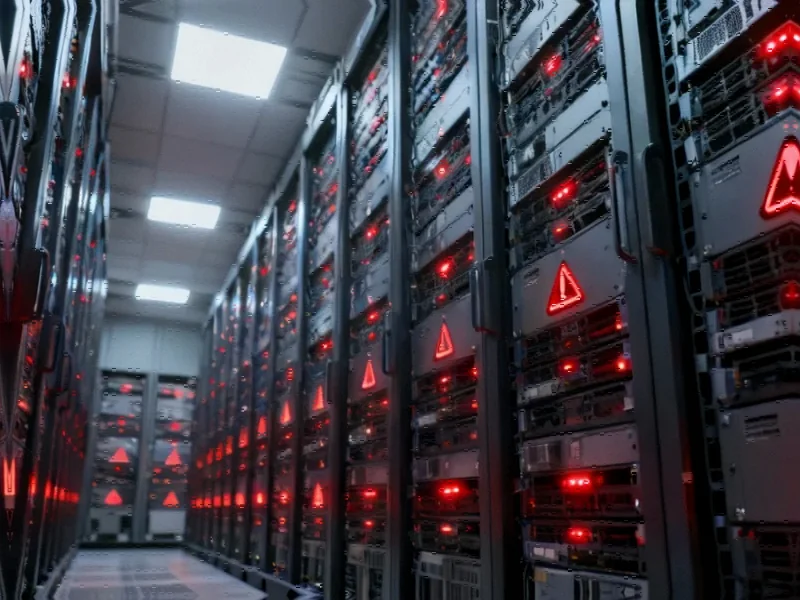The Domino Effect of Cloud Infrastructure Failure
A massive disruption in Amazon Web Services’ US-EAST-1 region in North Virginia triggered widespread digital service failures across multiple continents today, highlighting the fragile interdependence of modern cloud infrastructure. The outage, which began during peak business hours in North America, affected everything from smart home devices to social media platforms, demonstrating how critical AWS has become to global digital operations.
Understanding the AWS Infrastructure Breakdown
The disruption appears to have originated from what AWS described as an “operational issue” affecting multiple availability zones within its Northern Virginia data centers. This region, known as US-EAST-1, serves as one of AWS’s oldest and most critical infrastructure hubs, hosting countless enterprise applications and consumer services. The cascading failure began around 7:40 AM BST and quickly spread to dependent services worldwide.
According to detailed analysis of the AWS service disruption, the incident affected core computing services including EC2 instances, Lambda functions, and DynamoDB databases. This comprehensive breakdown prevented dependent applications from processing requests or accessing stored data, creating a digital paralysis that impacted millions of users simultaneously.
Impact Across Service Categories
The outage’s reach extended far beyond initial reports, affecting services across multiple categories:
- Smart Home Ecosystem: Alexa voice services became unresponsive, while Ring security systems lost connectivity, leaving homes without automated controls or security monitoring
- Social Media Platforms: Snapchat experienced significant service degradation, with users unable to send messages or access stories
- Enterprise Services: Numerous business applications relying on AWS infrastructure faced operational challenges
- Content Delivery Networks: Streaming services and content platforms experienced buffering and loading issues
The Broader Technology Context
This incident occurs amid significant transformations in artificial intelligence adoption across consumer and enterprise sectors. As companies increasingly rely on cloud infrastructure to power AI-driven services, the vulnerability of centralized systems becomes more apparent. The outage demonstrates how dependent modern AI applications have become on consistent cloud availability.
Meanwhile, regulatory frameworks continue to evolve around technology transparency. Recent mandates requiring AI disclosure in law enforcement highlight growing concerns about algorithmic accountability. Today’s infrastructure failure raises parallel questions about transparency in cloud service reliability and incident reporting.
Infrastructure Monitoring and Earth Observation
The incident underscores the importance of robust monitoring systems. Interestingly, advances in satellite surveillance and earth observation technologies are creating new possibilities for infrastructure monitoring. While today’s failure occurred at the software and operations level, the integration of spatial data with cloud management systems could provide additional layers of resilience in the future.
Global Workforce and Economic Implications
The disruption occurred against the backdrop of significant transformations in global workforce mobility and remote work patterns. As businesses increasingly rely on cloud-based collaboration tools, such infrastructure failures can paralyze distributed teams and disrupt international operations. The economic impact extends beyond immediate service disruption to affect productivity across multiple time zones and industries.
Strategic Business Responses
In related corporate strategic developments, we’re seeing companies reassess their operational dependencies. Today’s AWS outage will likely accelerate existing trends toward multi-cloud strategies and hybrid infrastructure approaches. Businesses are increasingly recognizing that concentration risk in cloud providers requires careful management and contingency planning.
Lessons for Industrial Computing
For industrial computing professionals, this incident reinforces the critical importance of redundancy and failover mechanisms. While consumer services captured headlines, the disruption affected numerous industrial systems and IoT deployments. The event serves as a stark reminder that as industrial systems become more connected and cloud-dependent, their vulnerability to upstream infrastructure failures increases proportionally.
Moving forward, organizations must balance the efficiency of cloud concentration with the resilience of distributed systems. Today’s outage demonstrates that even the most sophisticated cloud providers remain susceptible to cascading failures, and that comprehensive business continuity planning must account for dependencies beyond direct control.
The Path to More Resilient Infrastructure
As services gradually restore functionality, the technology industry faces crucial questions about infrastructure design and dependency management. This incident will likely accelerate investments in multi-region deployment strategies, improved failover mechanisms, and more transparent incident communication protocols. The ultimate test will be how cloud providers and their customers collaborate to build more resilient digital ecosystems that can withstand such disruptions while maintaining essential services.
This article aggregates information from publicly available sources. All trademarks and copyrights belong to their respective owners.
Note: Featured image is for illustrative purposes only and does not represent any specific product, service, or entity mentioned in this article.



